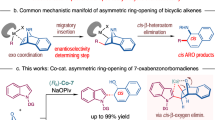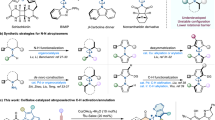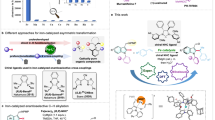Abstract
Enantioselective C–H functionalization for the synthesis of chiral molecules is a challenge in organic synthesis. Although there are several methods for atroposelective C–H functionalization to form C–N axially chiral anilides based on preformed aromatic ring systems, methods that construct N-heterocycles are relatively under-explored. Here we report a cobalt-catalysed enantioselective C–H activation and annulation process for the atroposelective synthesis of isoquinolines. The reaction proceeds under mild conditions using Co(OAc)2·4H2O with a chiral salicyl-oxazoline (Salox) ligand and O2 as an oxidant. The reaction tolerates a broad range of benzamides and internal and terminal alkynes, producing a range of C–N axially chiral isoquinolinones in excellent yield and enantioselectivity (up to 98% yield and 98% e.e.). Mechanistic studies infer that the process proceeds through a CoIII/CoI catalytic cycle, with the C–N reductive elimination step being stereo-determining. The isoquinolinone products show atropostability and thermal resistance and are suitable ligands for the Pd-catalysed enantioselective C–H functionalization of indole.

This is a preview of subscription content, access via your institution
Access options
Subscribe to this journal
Receive 12 digital issues and online access to articles
$119.00 per year
only $9.92 per issue
Buy this article
- Purchase on Springer Link
- Instant access to full article PDF
Prices may be subject to local taxes which are calculated during checkout




Similar content being viewed by others
Data availability
All data relating to the experimental procedures, optimization studies and characterization of the new compounds are in the Supplementary Information. Crystallographic data for the structures reported in this Article have been deposited at the Cambridge Crystallographic Data Centre, under deposition numbers CCDC 2121762 (3aa), CCDC 2129412 (3ar), CCDC 2165266 (3av-major), CCDC 2165270 (3av-minor) and CCDC 2165271 (9). Copies of the CCDC data can be obtained free of charge via https://www.ccdc.cam.ac.uk/structures/.
References
Jiang, H.-L. et al. New isocoumarins and alkaloid from Chinese insect medicine, Eupolyphaga sinensis Walker. Fitoterapia 83, 1275–1280 (2012).
Glunz, P. W. Recent encounters with atropisomerism in drug discovery. Bioorg. Med. Chem. Lett. 28, 53–60 (2018).
Mino, T. et al. Synthesis and application of P,olefin type axially chiral ligands with sec-alkyl groups. Org. Biomol. Chem. 17, 1455–1465 (2019).
Dial, B. E., Pellechia, P. J., Smith, M. D. & Shimizu, K. D. Proton grease: an acid accelerated molecular rotor. J. Am. Chem. Soc. 134, 3675–3678 (2012).
Bringmann, G. et al. Atroposelective synthesis of axially chiral biaryl compounds. Angew. Chem. Int. Ed. 44, 5384–5427 (2005).
Wencel-Delord, J., Panossian, A., Leroux, F. R. & Colobert, F. Recent advances and new concepts for the synthesis of axially stereoenriched biaryls. Chem. Soc. Rev. 44, 3418–3430 (2015).
Wang, Y.-B. & Tan, B. Construction of axially chiral compounds via asymmetric organocatalysis. Acc. Chem. Res. 51, 534–547 (2018).
Metrano, A. J. & Miller, S. J. Peptide-based catalysts reach the outer sphere through remote desymmetrization and atroposelectivity. Acc. Chem. Res. 52, 199–215 (2019).
Liu, Z.-S. et al. Construction of axial chirality via palladium/chiral norbornene cooperative catalysis. Nat. Catal. 3, 727–733 (2020).
Liu, C.-X., Zhang, W.-W., Yin, S.-Y., Gu, Q. & You, S.-L. Synthesis of atropisomers by transition-metal-catalyzed asymmetric C-H functionalization reactions. J. Am. Chem. Soc. 143, 14025–14040 (2021).
Kumarasamy, E., Raghunathan, R., Sibi, M. P. & Sivaguru, J. Nonbiaryl and heterobiaryl atropisomers: molecular templates with promise for atropselective chemical transformations. Chem. Rev. 115, 11239–11300 (2015).
Li, Z. & Yu, S. Asymmetric synthesis of atropisomeric compounds with C-N chiral axis. Sci. Sin. Chim. 50, 509–525 (2020).
Kitagawa, O. Chiral Pd-catalyzed enantioselective syntheses of various N-C axially chiral compounds and their synthetic applications. Acc. Chem. Res. 54, 719–730 (2021).
Kitagawa, O., Kohriyama, M. & Taguchi, T. Catalytic asymmetric synthesis of optically active atropisomeric anilides through enantioselective N-allylation with chiral Pd-tol-BINAP catalyst. J. Org. Chem. 67, 8682–8684 (2002).
Terauchi, J. & Curran, D. P. N-allylation of anilides with chiral palladium catalysts: the first catalytic asymmetric synthesis of axially chiral anilides. Tetrahedron Asymm. 14, 587–592 (2003).
Kitagawa, O., Takahashi, M., Yoshikawa, M. & Taguchi, T. Efficient synthesis of optically active atropisomeric anilides through catalytic asymmetric N-arylation reaction. J. Am. Chem. Soc. 127, 3676–3677 (2005).
Li, S.-L. et al. Atroposelective catalytic asymmetric allylic alkylation reaction for axially chiral anilides with achiral Morita-Baylis-Hillman carbonates. J. Am. Chem. Soc. 140, 12836–12843 (2018).
Lu, S. et al. Practical access to axially chiral sulfonamides and biaryl amino phenols via organocatalytic atroposelective N-alkylation. Nat. Commun. 10, 3061 (2019).
Fan, X., Zhang, X., Li, C. & Gu, Z. Enantioselective atropisomeric anilides synthesis via Cu-catalyzed intramolecular adjacent C−N coupling. ACS Catal. 9, 2286–2291 (2019).
Liu, Z.-S. et al. An axial-to-axial chirality transfer strategy for atroposelective construction of C–N axial chirality. Chem 7, 1917–1932 (2021).
Brandes, S., Bella, M., Kjaersgaard, A. & Jørgensen, K. A. Chirally aminated 2-naphthols—organocatalytic synthesis of nonbiaryl atropisomers by asymmetric Friedel-Crafts amination. Angew. Chem. Int. Ed. 45, 1147–1151 (2006).
Di Iorio, N. et al. Remote control of axial chirality: aminocatalytic desymmetrization of N-arylmaleimides via vinylogous Michael addition. J. Am. Chem. Soc. 136, 10250–10253 (2014).
Tanaka, K., Takeishi, K. & Noguchi, K. Enantioselective synthesis of axially chiral anilides through rhodium-catalyzed [2 + 2 + 2] cycloaddition of 1,6-diynes with trimethylsilylynamides. J. Am. Chem. Soc. 128, 4586–4587 (2006).
Wang, L., Zhong, J. & Lin, X. Atroposelective phosphoric acid catalyzed three-component cascade reaction: enantioselective synthesis of axially chiral N-arylindoles. Angew. Chem. Int. Ed. 58, 15824–15828 (2019).
Zhang, L., Zhang, J., Ma, J., Cheng, D.-J. & Tan, B. Highly atroposelective synthesis of arylpyrroles by catalytic asymmetric Paal-Knorr reaction. J. Am. Chem. Soc. 139, 1714–1717 (2017).
Wang, Y.-B., Zheng, S.-C., Hu, Y.-M. & Tan, B. Brønsted acid-catalysed enantioselective construction of axially chiral arylquinazolinones. Nat. Commun. 8, 15489 (2017).
Yao, Q.-J. et al. Enantioselective synthesis of atropisomeric anilides via Pd(II)-catalyzed asymmetric C-H olefination. J. Am. Chem. Soc. 142, 18266–18276 (2020).
Li, H. et al. Enantioselective synthesis of C-N axially chiral N-aryloxindoles by asymmetric rhodium-catalyzed dual C-H activation. Angew. Chem. Int. Ed. 58, 6732–6736 (2019).
Ye, C.-X. et al. Atroposelective synthesis of axially chiral N-arylpyrroles by chiral-at-rhodium catalysis. Angew. Chem. Int. Ed. 59, 13552–13556 (2020).
Dhawa, U. et al. Enantioselective palladaelectro-catalyzed C-H olefinations and allylations for N-C axial chirality. Chem. Sci. 12, 14182–14188 (2021).
Sun, L. et al. Rhodium-catalyzed atroposelective construction of indoles via C-H bond activation. Angew. Chem. Int. Ed. 60, 8391–8395 (2021).
Woźniak, Ł. & Cramer, N. Enantioselective C-H bond functionalizations by 3d transition-metal catalysts. Trends Chem. 1, 471–484 (2019).
Loup, J., Dhawa, U., Pesciaioli, F., WencelDelord, J. & Ackermann, L. Enantioselective C-H activation with earth-abundant 3d transition metals. Angew. Chem. Int. Ed. 58, 12803–12818 (2019).
Yoshino, T. & Matsunaga, S. Chiral carboxylic acid assisted enantioselective C-H activation with achiral CpXMIII (M = Co, Rh, Ir) catalysts. ACS Catal. 11, 6455–6466 (2021).
Jacob, N., Zaid, Y., Oliveira, J. C. A., Ackermann, L. & Wencel-Delord, J. Cobalt-catalyzed enantioselective C-H arylation of indoles. J. Am. Chem. Soc. 144, 798–806 (2022).
Pesciaioli, F. et al. Enantioselective cobalt(III)-catalyzed C-H activation enabled by chiral carboxylic acid cooperation. Angew. Chem. Int. Ed. 57, 15425–15429 (2018).
Fukagawa, S. et al. Cobalt(III)/chiral carboxylic acid-catalyzed enantioselective C(sp3)-H amidation of thioamides. Angew. Chem. Int. Ed. 58, 1153–1157 (2019).
Sekine, D. et al. Chiral 2-aryl ferrocene carboxylic acids for the catalytic asymmetric C(sp3)-H activation of thioamides. Organometallics 38, 3921–3926 (2019).
Liu, Y.-H. et al. Cp*Co(III)/MPAA-catalyzed enantioselective amidation of ferrocenes directed by thioamides under mild conditions. Org. Lett. 21, 1895–1899 (2019).
Kurihara, T., Kojima, M., Yoshino, T. & Matsunaga, S. Cp*CoIII/chiral carboxylic acid-catalyzed enantioselective 1,4-addition reactions of indoles to maleimides. Asian J. Org. Chem. 9, 368–371 (2020).
Liu, Y.-H. et al. Cp*Co(III)-catalyzed enantioselective hydroarylation of unactivated terminal alkenes via C-H activation. J. Am. Chem. Soc. 143, 19112–19120 (2021).
Ozols, K., Jang, Y.-S. & Cramer, N. Chiral cyclopentadienyl cobalt(III) complexes enable highly enantioselective 3d-metal-catalyzed C-H functionalizations. J. Am. Chem. Soc. 141, 5675–5680 (2019).
Ozols, K., Onodera, S., Woz´niak, L. & Cramer, N. Cobalt(III)-catalyzed enantioselective intermolecular carboamination by C-H functionalization. Angew. Chem. Int. Ed. 60, 655–659 (2021).
Herraiz, A. G. & Cramer, N. Cobalt(III)-catalyzed diastereo- and enantioselective three-component C-H functionalization. ACS Catal. 11, 11938–11944 (2021).
Yuan, W.-K. & Shi, B.-F. Synthesis of chiral spirolactams via sequential C-H olefination/asymmetric [4 + 1] spirocyclization under a simple Co(II)/chiral spiro phosphoric acid binary system. Angew. Chem. Int. Ed. 60, 23187–23192 (2021).
Yao, Q.-J., Chen, J.-H., Song, H., Huang, F.-R. & Shi, B.-F. Cobalt/Salox‐catalyzed enantioselective C-H functionalization of arylphosphinamides. Angew. Chem. Int. Ed. 134, e202202892 (2022).
Grigorjeva, L. & Daugulis, O. Cobalt-catalyzed, aminoquinoline-directed C(sp2)-H bond alkenylation by alkynes. Angew. Chem. Int. Ed. 53, 10209–10212 (2014).
Zhang, L.-B. et al. Cobalt(II)-catalyzed Csp2-H alkynylation/annulation with terminal alkynes: selective access to 3-methyleneisoindolin-1-one. Angew. Chem. Int. Ed. 54, 10012–10015 (2015).
Bao, X., Rodriguez, J. & Bonne, D. Enantioselective synthesis of atropisomers with multiple stereogenic axes. Angew. Chem. Int. Ed. 59, 12623–12634 (2020).
Gao, Q. et al. Catalytic synthesis of atropisomeric o-terphenyls with 1,2-diaxes via axial-to-axial diastereoinduction. J. Am. Chem. Soc. 143, 7253–7260 (2021).
Acknowledgements
This work was supported by the National Natural Science Foundation of China (21772179 to J.-L.N.) and the Program for Science & Technology Innovation Talents in Universities of Henan Province (19HASTIT038 to J.-L.N.).
Author information
Authors and Affiliations
Contributions
J.-L.N., D.Y. and X.-J.S. conceived the concept and prepared the manuscript. X.-J.S., D.Y. and M.-C.S. conducted the experiments and analysed the data. D.W. performed the DFT study. M.-P.S. provided revisions. All authors participated in the discussion and preparation of the manuscript. J.-L.N. directed the project.
Corresponding author
Ethics declarations
Competing interests
The authors declare no competing interests.
Peer review
Peer review information
Nature Synthesis thanks Naohiko Yoshikai, Qianghui Zhou and the other, anonymous, reviewer(s) for their contribution to the peer review of this work. Primary Handling Editor: Thomas West, in collaboration with the Nature Synthesis team.
Additional information
Publisher’s note Springer Nature remains neutral with regard to jurisdictional claims in published maps and institutional affiliations.
Supplementary information
Supplementary Data 1
Crystallographic data for compound 3aa, CCDC 2121762
Supplementary Data 2
Crystallographic data for compound 3ar, CCDC 2129412
Supplementary Data 3
Crystallographic data for compound 3av-major, CCDC 2165266
Supplementary Data 4
Crystallographic data for compound 3av-minor, CCDC 2165270
Supplementary Data 5
Crystallographic data for compound 9, CCDC 2165271
Rights and permissions
About this article
Cite this article
Si, XJ., Yang, D., Sun, MC. et al. Atroposelective isoquinolinone synthesis through cobalt-catalysed C–H activation and annulation. Nat. Synth 1, 709–718 (2022). https://doi.org/10.1038/s44160-022-00114-4
Received:
Accepted:
Published:
Issue Date:
DOI: https://doi.org/10.1038/s44160-022-00114-4
This article is cited by
-
Diastereo- and atroposelective synthesis of N-arylpyrroles enabled by light-induced phosphoric acid catalysis
Nature Communications (2023)
-
Cobalt-catalyzed atroposelective C−H activation/annulation to access N−N axially chiral frameworks
Nature Communications (2023)
-
Atroposelective desymmetrization of 2-arylresorcinols via Tsuji-Trost allylation
Communications Chemistry (2023)
-
Rhodium-catalyzed enantioselective and diastereodivergent access to diaxially chiral heterocycles
Nature Communications (2023)
-
Cobalt selectively annulates
Nature Synthesis (2022)



